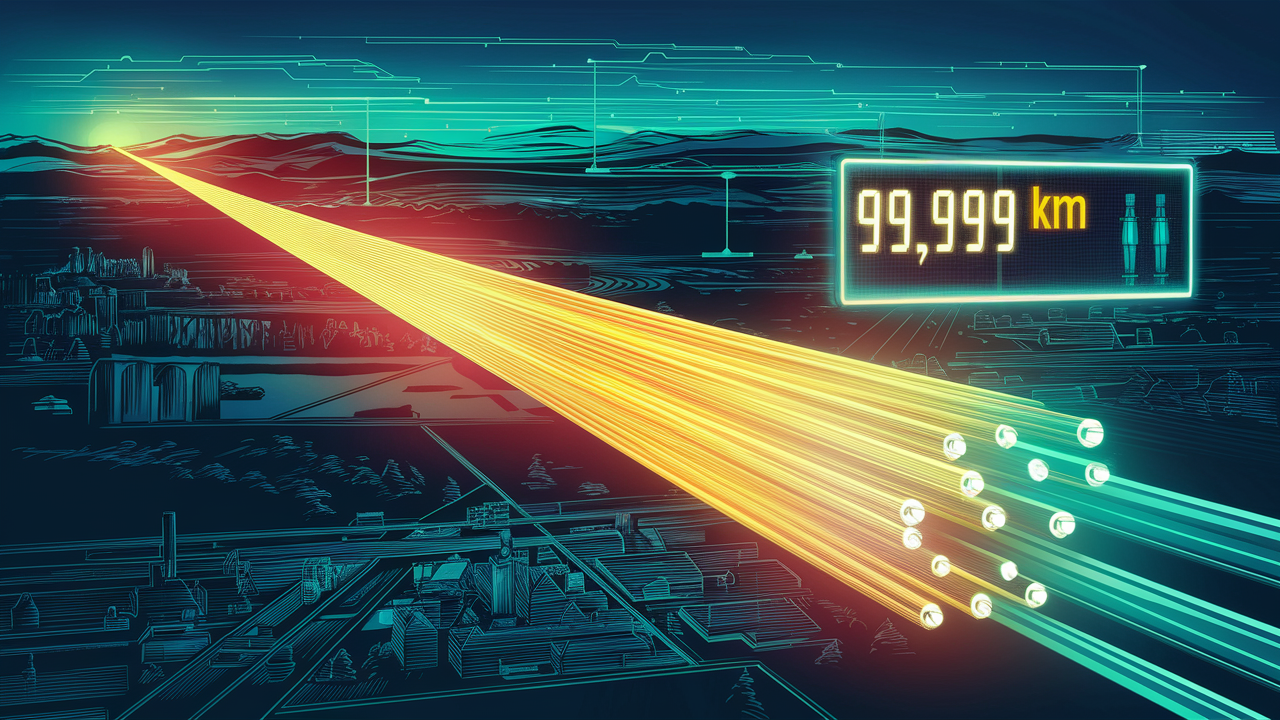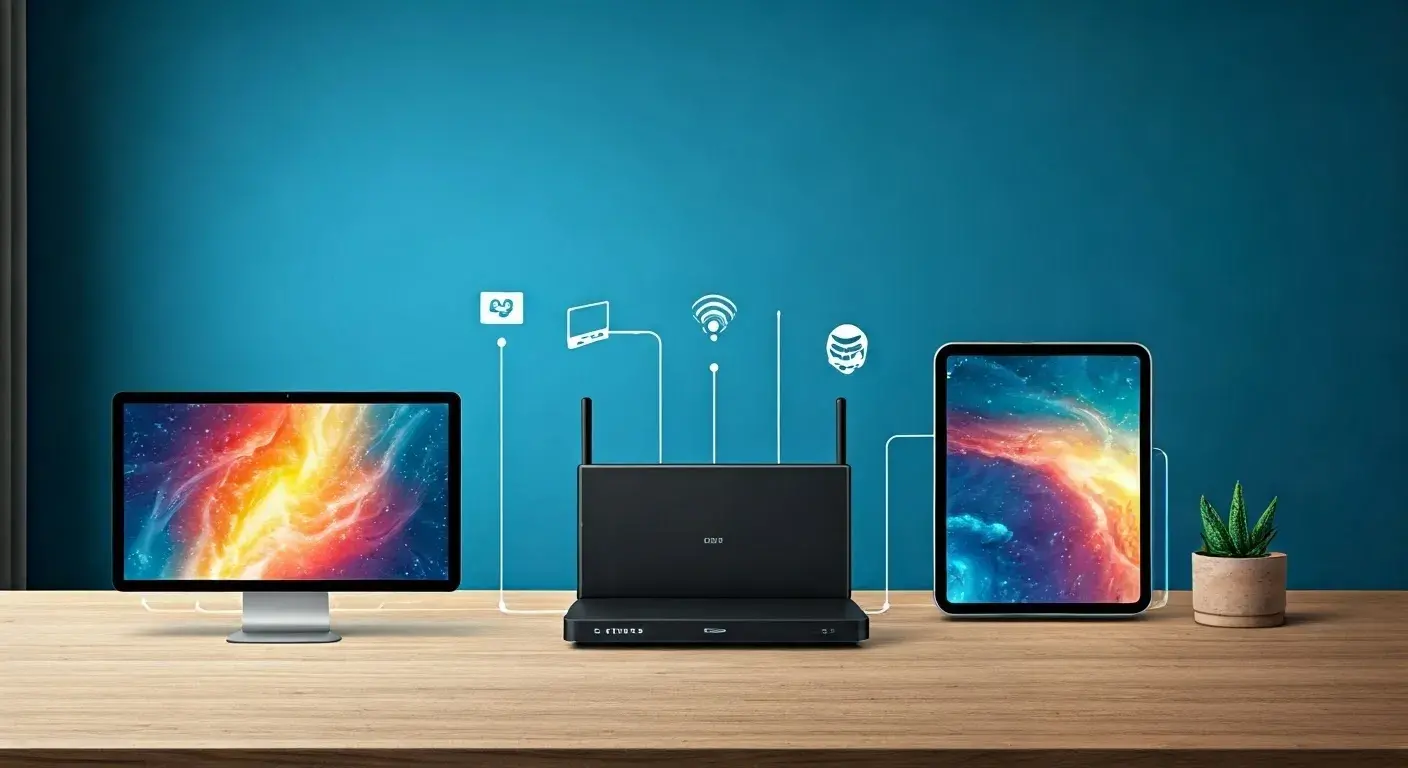What is the maximum distance for fiber internet?

Understanding the maximum distance for fiber internet is crucial for both service providers and consumers. This comprehensive guide explores the technical limitations, real-world scenarios, and future possibilities, offering clear insights into how far fiber can truly reach.
Understanding Fiber Optic Cable Distance Limitations
When we talk about fiber internet, the question of "how far can it go?" is paramount. Unlike traditional copper cables that degrade significantly over shorter distances, fiber optics offer vastly superior performance. However, even light signals traveling through glass fibers are not immune to limitations. The maximum distance a fiber optic cable can transmit data reliably is influenced by several key factors, primarily the inherent properties of light and the physical characteristics of the fiber itself. Understanding these limitations is essential for designing efficient and robust internet infrastructure, especially as we aim to expand high-speed connectivity to more remote areas. In 2025, the demand for ubiquitous, high-bandwidth internet continues to drive innovation in overcoming these distance barriers.
The Primary Culprit: Signal Loss (Attenuation)
The most significant factor limiting the distance of fiber optic communication is signal loss, scientifically known as attenuation. Attenuation refers to the gradual decrease in the intensity of a light signal as it propagates through the optical fiber. Think of it like shouting in a crowded room – the further your voice travels, the fainter it becomes until it's indistinguishable from background noise. In fiber optics, this "noise" is other forms of signal degradation, and the "faintness" means the receiver can no longer reliably interpret the data.
Types of Attenuation
Attenuation in fiber optic cables can be categorized into several types, each contributing to the overall signal degradation:
- Absorption: This occurs when impurities within the glass of the fiber absorb some of the light energy, converting it into heat. While modern fiber manufacturing processes have minimized impurities, this remains a factor.
- Scattering: This happens when light encounters imperfections or variations in the refractive index of the fiber core. The light is deflected in various directions, some of which escapes the core and is lost. Rayleigh scattering, caused by microscopic density fluctuations in the glass, is a primary contributor, especially at shorter wavelengths.
- Bending Losses: When a fiber optic cable is bent too sharply, light can escape the core. There are two types of bending:
- Macrobending: Large-scale bends, typically caused by improper installation or handling.
- Microbending: Small, microscopic bends along the fiber, often due to pressure or stress on the cable jacket.
- Connection Losses: Every time two fiber optic cables are joined (e.g., at splices or connectors), some signal loss occurs due to slight misalignments, air gaps, or surface imperfections.
Factors Affecting Attenuation
Several external and internal factors influence the rate of attenuation:
- Wavelength of Light: Different wavelengths of light experience different levels of attenuation. For example, the 1550 nm wavelength is commonly used for long-haul transmission because it experiences the lowest attenuation in standard silica fibers.
- Fiber Material and Purity: The quality of the glass used in the fiber core is critical. Higher purity materials and advanced manufacturing techniques result in lower absorption and scattering.
- Fiber Construction: The design of the fiber, including its core diameter and cladding properties, affects how light propagates and is contained.
- Environmental Conditions: Temperature fluctuations, moisture, and physical stress on the cable can all contribute to increased attenuation, particularly through bending losses.
- Cable Quality and Installation: The protective jacketing of the cable and the care taken during installation (avoiding sharp bends, proper splicing) significantly impact signal integrity over distance.
Standard Maximum Distances for Fiber Internet
The "maximum distance" for fiber internet isn't a single, fixed number. It depends heavily on the type of fiber optic cable used, the specific application, and the technology employed to transmit and receive the light signals. In 2025, understanding these distinctions is key to appreciating the capabilities and limitations of fiber networks.
Single-Mode vs. Multi-Mode Fiber
The most fundamental distinction in fiber optic cables, and one that directly impacts transmission distance, is between single-mode fiber (SMF) and multi-mode fiber (MMF).
- Single-Mode Fiber (SMF): SMF has a very small core diameter (typically 9 micrometers). This small core allows only one mode, or path, for light to travel through. This single path minimizes modal dispersion (where different light paths arrive at different times), allowing the signal to travel much further with less degradation. SMF is the backbone of long-haul telecommunications, undersea cables, and high-speed internet backbones.
- Multi-Mode Fiber (MMF): MMF has a larger core diameter (typically 50 or 62.5 micrometers). This larger core allows multiple modes of light to propagate simultaneously. While easier to connect and less expensive for shorter runs, the different paths light takes lead to modal dispersion, which limits the distance over which the signal can be reliably transmitted. MMF is commonly used for shorter distances within buildings, data centers, and local area networks (LANs).
Typical Distances for Different Applications
The practical maximum distance for fiber internet varies significantly based on the application and the type of fiber used. Here's a breakdown as of 2025:
For Multi-Mode Fiber (MMF):
- Short Reach (e.g., within a building, data center): For speeds up to 1 Gbps, MMF can typically reach up to 2 kilometers (approx. 1.2 miles).
- Medium Reach (e.g., campus networks): For speeds of 10 Gbps, the distance is generally limited to around 300-550 meters (approx. 0.18-0.34 miles), depending on the fiber grade (OM3, OM4, OM5).
- Higher Speeds (e.g., 40 Gbps, 100 Gbps): At these speeds, MMF distances are significantly reduced, often to around 100-150 meters (approx. 0.06-0.09 miles) for OM4/OM5 fiber.
For Single-Mode Fiber (SMF):
SMF is where we see the truly impressive distances. The exact distance is influenced by the specific equipment (transceivers), the wavelength used, and the quality of the fiber.
- Standard Ethernet Links (e.g., 1 Gbps, 10 Gbps): Using standard transceivers, SMF can easily transmit data over 10 kilometers (approx. 6.2 miles) to 40 kilometers (approx. 25 miles) without the need for signal regeneration.
- Long-Haul Networks (e.g., metro, regional): With more advanced transceivers and potentially lower data rates per wavelength, SMF can cover distances of 80 kilometers (approx. 50 miles) to 120 kilometers (approx. 75 miles).
- Ultra-Long-Haul Networks (e.g., intercontinental, backbone): This is where fiber truly shines. For critical backbone infrastructure, data can be transmitted over thousands of kilometers. While individual segments might be around 100-200 km before requiring regeneration or amplification, the cumulative distance through a series of these segments can span the globe. For instance, undersea cables connecting continents can be tens of thousands of kilometers long, utilizing advanced amplification and multiplexing technologies.
It's important to note that these are general guidelines. The specific performance of any fiber optic link depends on a combination of the fiber type, the optical transceivers at each end, and the overall network design.
Strategies for Overcoming Distance Challenges
While single-mode fiber offers significant reach, pushing the boundaries of distance for fiber optic communication requires sophisticated techniques to combat signal degradation. These strategies are crucial for building robust, high-capacity networks that can span vast geographical areas.
Repeaters and Amplifiers
For distances exceeding the inherent reach of a single fiber segment, signal boosters are employed.
- Repeaters: These devices receive a weakened optical signal, convert it into an electrical signal, clean it up (regenerate it), and then convert it back into an optical signal. This process effectively "resets" the signal, allowing it to travel further. Repeaters are more complex and expensive than passive amplifiers.
- Optical Amplifiers (e.g., EDFAs - Erbium-Doped Fiber Amplifiers): These are passive devices that boost the optical signal directly without converting it to an electrical signal. They are widely used in long-haul and undersea networks. EDFAs are particularly effective for amplifying signals in the 1550 nm wavelength range, which has the lowest attenuation.
In 2025, these technologies are standard in long-haul networks, enabling signals to travel across continents and oceans.
Dispersion Management
Beyond attenuation, another key factor limiting distance is dispersion. Dispersion refers to the spreading of the light pulse as it travels down the fiber. This spreading can cause overlapping pulses, making it difficult for the receiver to distinguish between individual bits of data.
- Chromatic Dispersion (CD): This occurs because different wavelengths (colors) of light travel at slightly different speeds through the fiber.
- Polarization Mode Dispersion (PMD): This happens because imperfections in the fiber can cause different polarization states of light to travel at different speeds.
To combat dispersion, engineers use various techniques:
- Dispersion-Compensating Fiber (DCF): This is a special type of fiber with a negative dispersion coefficient, meaning it can counteract the positive dispersion of standard fiber.
- Fiber Bragg Gratings (FBGs): These are optical components that selectively reflect certain wavelengths, helping to manage dispersion.
- Electronic Dispersion Compensation (EDC): Advanced digital signal processing (DSP) techniques used in high-speed transceivers can electronically compensate for dispersion. This is becoming increasingly common in modern high-speed systems.
Advanced Modulation Techniques
Modern fiber optic systems use sophisticated modulation techniques to encode more data onto the light signal and improve its resilience to degradation.
- Wavelength Division Multiplexing (WDM): This technology allows multiple optical signals, each at a different wavelength (color) of light, to be transmitted simultaneously over a single fiber. This dramatically increases the capacity of existing fiber infrastructure. Dense WDM (DWDM) systems can carry hundreds of wavelengths, achieving terabits per second over a single fiber pair.
- Advanced Modulation Formats (e.g., QAM): Techniques like Quadrature Amplitude Modulation (QAM) are used to encode more bits per symbol, increasing spectral efficiency and data rates. These methods require sophisticated digital signal processing to encode and decode the signals, making them suitable for high-end, long-haul applications.
Network Design and Topology
The way a fiber optic network is designed and laid out plays a crucial role in its overall reach and reliability.
- Point-to-Point vs. Ring vs. Mesh: Different topologies have different strengths. For long distances, point-to-point links with regeneration points are common. Ring topologies offer redundancy, while mesh networks provide high resilience.
- Strategic Placement of Amplifiers and Regenerators: Careful planning of where to place signal boosters is essential to maintain signal integrity across long routes.
- Use of Different Fiber Types: Networks often use a combination of SMF for long hauls and MMF for shorter connections within facilities.
Real-World Fiber Deployments and Distances
The theoretical maximum distances for fiber optics are impressive, but how do these translate into practical, real-world deployments in 2025? The answer varies significantly depending on the context, from local neighborhood networks to global telecommunications backbones.
Urban and Suburban Networks
In cities and suburban areas, fiber-to-the-home (FTTH) networks are designed to connect individual residences and businesses.
- Last Mile Connectivity: The "last mile" refers to the final segment of the network connecting the service provider's central office or local exchange to the end-user. For FTTH, this typically involves single-mode fiber. The distances here are generally much shorter than long-haul networks, often ranging from a few hundred meters to a few kilometers (up to 1-2 miles) from the distribution point to the home.
- Provider Infrastructure: Within urban areas, the fiber infrastructure connecting different exchanges, cell towers, and enterprise customers can extend for tens of kilometers, often utilizing DWDM to maximize capacity over these routes.
- Example: A typical FTTH deployment might have a fiber backbone running through a city, with distribution cabinets placed every few hundred meters. From these cabinets, individual fiber strands run to each home, with the total distance from the central office to the furthest home rarely exceeding 10-20 km.
Rural Broadband Initiatives
Expanding fiber internet to rural and underserved areas presents unique challenges due to the vast distances and lower population densities.
- Longer Feeder Routes: To connect rural communities, fiber optic cables often need to traverse many kilometers from the nearest urban hub or central office. These "feeder" routes can easily extend for 20, 50, or even 100+ kilometers.
- Strategic Amplification: To cover these distances efficiently, these routes will incorporate optical amplifiers at regular intervals (e.g., every 80-100 km) to boost the signal.
- Government and Private Investment: Initiatives in 2025 continue to focus on bridging the digital divide, with significant investments in extending fiber infrastructure to remote regions. This often involves deploying single-mode fiber with carefully planned amplification points.
- Example: A project to bring fiber to a remote town might involve a 70 km fiber run from the nearest city, requiring one set of optical amplifiers midway to ensure signal strength reaches the town's local exchange.
Long-Haul Telecommunications
This is where fiber optics demonstrates its unparalleled ability to span immense distances.
- Terrestrial Long-Haul: Fiber optic cables laid across continents can cover thousands of kilometers. These networks are built with segments of approximately 80-120 km, each equipped with optical amplifiers. DWDM technology is extensively used to carry vast amounts of data over these routes.
- Submarine Cables: The ultimate test of fiber optic distance is undersea. These cables, laid on the ocean floor, connect continents and can be over 20,000 km long. They rely on a dense network of optical amplifiers spaced every 50-100 km, powered by electricity sent down the cable itself. The signal is incredibly robust, but even here, the fundamental limits of attenuation and dispersion must be managed.
- Example: The SEA-ME-WE 3 cable system, for instance, stretches over 39,000 km, connecting Europe to Southeast Asia and Australia. This is achieved through numerous repeaters and sophisticated signal processing.
In 2025, the trend is towards higher capacity over these long distances, with ongoing research into even more efficient amplification and modulation techniques to push these limits further.
The Future of Fiber Optic Distance
The quest to extend the reach and capacity of fiber optic networks is an ongoing endeavor. While current technologies already enable global connectivity, future advancements promise even greater distances and performance, driven by evolving technological capabilities and increasing global demand for data.
Emerging Technologies
Several cutting-edge technologies are poised to redefine the limits of fiber optic transmission distances and capabilities:
- Hollow-Core Fibers: Unlike traditional fibers made of solid glass, hollow-core fibers have a central air or gas channel. Light travels through this hollow core, significantly reducing non-linear effects and dispersion. This can lead to lower latency and potentially longer transmission distances without regeneration, especially at very high speeds. Prototypes have shown promising results for future ultra-long-haul applications.
- Coherent Optics and Advanced DSP: The sophistication of digital signal processing (DSP) in coherent optical transceivers continues to advance. These systems can precisely compensate for complex impairments like chromatic dispersion and polarization mode dispersion, allowing for higher data rates over longer distances. Future DSP advancements will enable even more robust signal recovery from weakened and distorted signals.
- Raman Amplification: Beyond EDFAs, Raman amplification is another technique that can boost optical signals. It uses a pump laser to stimulate the fiber itself to amplify the signal, offering more flexibility and potentially higher gains, especially for very long spans or specific wavelengths.
- New Fiber Materials: Research into alternative fiber materials beyond silica could lead to fibers with lower intrinsic attenuation or different dispersion characteristics, opening up new possibilities for distance.
Impact of 5G and IoT
The rapid expansion of 5G mobile networks and the Internet of Things (IoT) will place unprecedented demands on fiber optic infrastructure.
- Backhaul Demands: 5G base stations require significantly higher bandwidth backhaul than previous generations. This necessitates denser fiber deployments and the ability to extend fiber to more locations, even in challenging terrains. The increased number of connections means that while individual links might not be drastically longer, the overall network complexity and the need for reliable signal transmission over all these links become paramount.
- IoT Connectivity: The proliferation of IoT devices, from smart sensors to autonomous vehicles, will generate massive amounts of data. This data needs to be transmitted efficiently and with low latency, further driving the need for widespread, high-capacity fiber networks. Even if individual IoT devices are not connected directly via long-haul fiber, the aggregation points and data centers processing this information will rely on robust, long-distance fiber links.
- Edge Computing: The trend towards edge computing, where data processing occurs closer to the source, will require more distributed fiber networks. This means extending fiber further into metropolitan and even suburban areas, potentially pushing the "edge" of high-speed fiber closer to end-users and devices.
In essence, the growth of 5G and IoT will not necessarily extend the absolute maximum distance of a single fiber segment dramatically in the immediate future, but it will drive the deployment of fiber over longer total network distances and require more sophisticated management of signal integrity across a vastly expanded and interconnected web of fiber.
Conclusion: Unlocking the Full Potential of Fiber Distance
The question "What is the maximum distance for fiber internet?" doesn't have a single, simple answer. As of 2025, the capabilities are truly astounding. For standard residential connections, the "last mile" is typically measured in kilometers. However, when we look at the backbone infrastructure that powers our global communication, single-mode fiber, augmented by advanced technologies like DWDM, optical amplifiers, and sophisticated signal processing, can reliably transmit data across continents and oceans, covering distances of thousands of kilometers.
The primary limiting factor remains signal loss (attenuation) and signal dispersion, but these are effectively managed through careful engineering, high-quality materials, and innovative technological solutions. The continuous development of hollow-core fibers, advanced coherent optics, and new amplification techniques promises to push these boundaries even further. As 5G, IoT, and edge computing continue to drive demand for bandwidth and connectivity, the importance of maximizing fiber optic reach and capacity will only grow. Ultimately, fiber optics is the foundation of modern high-speed internet, and its ability to span vast distances is key to connecting the world.





